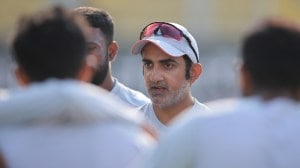Stay updated with the latest - Click here to follow us on Instagram
In 4 years, Mumbai’s largest veterinary hospital records 48% rise in cattle admission
The hospital is constantly on a lookout for shelter homes, as most available are filled to their capacity. In a month, the hospital receives about 15 abandoned cattle.
 At the Bai Sakarbai Dinshaw Petit Hospital for Animals.
At the Bai Sakarbai Dinshaw Petit Hospital for Animals.
SINCE 2015, when the state BJP-led government prohibited the slaughter of cow progeny, the largest veterinary hospital in the city, Bai Sakarbai Dinshaw Petit Hospital for Animals in Parel, has recorded a steady increase in the number of cows, bullocks and calves being admitted.
The hospital is constantly on a lookout for shelter homes, as most available are filled to their capacity. In a month, the hospital receives about 15 abandoned cattle.
“Previously, these animals used to be brought in by owners or the hospital used to rescue cattle following complaints from the public. Nowadays, organisations involved in saving cows, such as Bajrang Dal, Gowrakshak Samiti and others, bring the animals,” said Dr J C Khanna, the hospital medical superintendent.
In 2015, following a presidential nod, the state had banned the slaughter of bulls, bullocks and oxen through an amendment to the Maharashtra Animal Preservation Act, 1976. The slaughter of cows and calves was already prohibited. With the ban, a huge market of bull’s meat was affected. Farmers, who earlier sold their non-productive cattle to slaughterhouses, were forced to abandon them.
Data accessed by The Indian Express shows in 2015 — the first year of the ban — 102 cows, bulls, calves and bullocks were admitted in the hospital. The figure rose to 126 in 2016, 142 in 2017 and 151 in 2018. The rise in admissions has been 48 per cent in these four years.
Till July 15 this year, 68 cows, 32 calves and 12 bulls and bullocks have been rescued and admitted in the hospital.
Hospital caretakers claimed while some cattle are abandoned by their owners, in most cases, cows, calves and bulls are rescued by gau rakshaks from slaughter. “The NGOs bring them here after getting a case registered with police,” Khanna said.
With no home to return to, the hospital has 53 such animals in its permanent shelter. It has also constructed a new shelter for cows and bulls after their numbers escalated.
The prevailing issue now is the rehabilitation of abandoned cattle. Jayesh Shah, founder of NGO Shree Aadi Jin Yuvak Trust, which provides relief material for abandoned cattle, said there are 70 to 75 old age homes for cattle, called Panjarpoles, between Virar, Kalyan and Mumbai. “But all are full. When a shelter home refuses to admit a cow, it is taken to the hospital,” he added.
Experts said the state needs to set up more shelter homes. “We are also noticing high rates of abandonment of cattle because farmers can no longer afford fodder,” Shah said.
Dr Yogesh Shetye, general manager at Deonar abattoir, said that while the BMC can fine an owner for letting cattle stay in public areas, it cannot do anything about abandoned cattle. “The government has built shelters for them,” he said.







